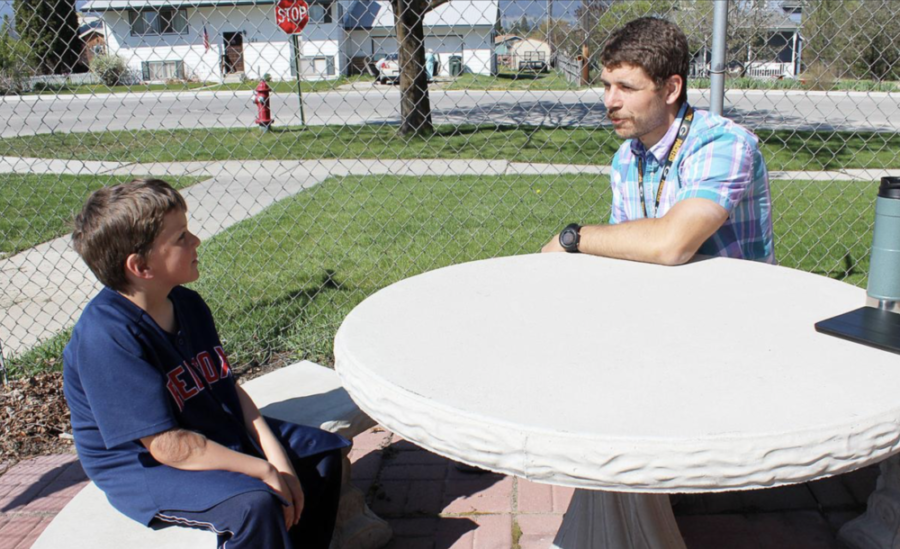When Lee Starck read about a recent 45 percent drop in reported cases of child abuse and neglect in Montana, he was skeptical.
“I think the opposite may be true,” said Starck, a K-4 school counselor in Stevensville, Montana. “When you think about the chronic stress of this time, the economic hardship, I doubt that's an accurate picture of what's going on.”
A new study suggests Starck is probably right. Three researchers found that reported cases of child maltreatment in Florida was 27 percent lower that it usually is this time of year. This drop is, in their words, “counterfactual” and is likely being mirrored across the country. School closures due to the COVID-19 pandemic, the researchers write, have severed the “link between child maltreatment victims and the number one source of reported maltreatment allegations - school personnel.”
School counselors and school psychologists, as part of their jobs, are mandated reporters of child abuse and neglect. These incidents, Starck fears, may be increasing due to the chronic stress - economic or health-related - some households are experiencing during this crisis.
Other students are just having difficulty coping with social isolation and the pressures of online learning. Whatever the challenge, the coronavirus has robbed many students of the valuable face-to-face guidance and support of their school counselors.
“School provides a routine and a sense of normalcy. The current situation is anything but routine and normal,” says Kathy Reamy, a school counselor in La Plata, Maryland, and chair of the NEA School Counselor Caucus. “In the absence of seeing our students at school in person, it's really difficult to get a sense of how they are doing.”
Like all the classroom teachers who transitioned practically overnight to online instruction, counselors have adjusted, tapping into their resourcefulness to reach their students and their families.
 School counselor Lee Starck with a student in 2016. “We don’t yet have the full picture of what many students have been experiencing.” (Photo courtesy of The Ravalli Republic)
School counselor Lee Starck with a student in 2016. “We don’t yet have the full picture of what many students have been experiencing.” (Photo courtesy of The Ravalli Republic)
There are obvious challenges. When kids are outside the safety - and privacy - of his office at school, “It can be difficult sensing their comfort level and overall sense of security,” says Starck.
Emily Klein, a school psychologist at Skyline Middle School in Wilmington, Delaware, has prioritized maintaining her relationships with students until the fall when, hopefully, she can meet with them face-to-face. “Remote conversations aren't really conducive to problem-solving or skills-building, the things we usually like to work on. So I'm focusing on staying in touch and keeping our bond strong.”
‘They Need to Know I’m Always Here’
Schools are a collaborative environment. Educators, regardless of their job title, draw from each other's experience and expertise to serve the best interest of students.
Starck misses the interaction and consultation with teachers at Stevensville. “They're extremely intuitive,” he says. “They know their students. They can pick up on red flags in the classroom and they let me know if something is wrong.”
Heidi Murray, a school counselor in Warren County, Ohio, didn't really appreciate until school closed the value of informal interactions with students. “You pass by them in the hallway. You sense their demeanor, what kind of day they're having. You get a pulse on where they are emotionally.”
Over the past two months, counselors have been staying at home, one hand on their laptop, the other holding their phone, using email, text, Google Voice, Zoom, - whatever takes to reconnect with students.
“It can be draining just to finally get them or their parents on the phone or on a video call,” admits Starck. “But when it happens, students seem happy to reconnect. Their faces light up. There’s joy and that keeps my fires lit as well.”
“Our caseloads are going to be overwhelming because students are likely to have some serious mental health issues when we reopen.” - Emily Klein, school psychologist
“It really helps to hear each other's voices, even if it's just over the phone,” adds Murray. “We're communicating.”
Kathy Reamy sends out a weekly video message via email to her students and their parents just to to check in or provide information and updates about the things they may be interested in, like graduation and prom. She also includes tips for reducing stress and anxiety with mindfulness activities, exercise, and stressing the the importance of staying in touch with friends.
For those students she's particularly concerned about, Reamy reaches out to them individually by phone, email or text.
Some students, however, can't be reached. “They aren't responding to any of my attempts to contact them, and neither are their parents. At least when they are coming to school there are multiple staff members who lay eyes on them on a daily basis. Now with some of them, despite all of our efforts, we have no idea how they're doing.”
Emily Klein continues to email parents every week, even if she hasn't heard back in a while. “They need to know that I'm always here.”
Zoom Has Its Limits
Most students at Stevensville have a Google account associated with the school, which Starck has used to initiate contact with students and heir parents. Once that contact has been established, and the student agrees, Starck schedules a video call over Zoom.
Talking to their counselor over video in their own homes with parents and siblings nearby, even in the same room, can be tricky. “The success of the session really depends on how comfortable the student is in that environment,” says Starck.
While acknowledging Zoom or some other platform is the the only viable option during this time, Klein has misgivings about the lack of student privacy.
“There may be someone else in the room that dampens the students' ability to be candid or forthright,” she explains. “So sometimes the session ends up with me getting a video tour of the house or saying hello to the family cat.”
The deficiencies around video are especially evident in Klein's work with special education eligibility. Student evaluations are due around this time of year. Klein can't properly carry out this task, at least with some of her students, without spending time with them. In addition, Klein and her colleagues often need more information to adequately plan for the student's needs, and that requires testing.
“The tests we use haven’t been normed, validated or standardized to administer them remotely,” she says. “As far as I'm concerned, it's not really an option.”
Those evaluations will need to completed when she returns, ensuring that a major backlog of work awaits her in the Fall. “We haven't received a whole lot of guidance. We're just told to wait until we get back.”
The problem with that, Klein adds, “is that our caseloads are going to be overwhelming because students are likely to have some serious mental health issues when we reopen.”
‘This Pandemic Will Change People Forever’
Over the past two months, student emotions have ping-ponged between anxiety and grief, says Starck. “Initially, they were worried about their health, their family's health, and the closures were so sudden. When it was clear school was not going to reopen in the spring, they grieved. It was a huge loss.”
“Now, as we begin to think about reopening, we're back to fear and anxiety. They're wondering, What will school be like? Will it ever be the same?”
Starck worries about the emotional state of many students - especially those from unstable home environments - when they return to school.
“We don't really know what the intensity of the anxiety and trauma has been. We don't yet have the full picture of what many students have been experiencing. That's unsettling to me.”
 School counselor Kathy Reamy. "In the absence of seeing our students at school in person, it's really difficult to get a sense of how they are doing."
School counselor Kathy Reamy. "In the absence of seeing our students at school in person, it's really difficult to get a sense of how they are doing."
According to the American School Counselor Association, a school should have no more than 250 students per student counselor. The good news is that this ratio has narrowed to its lowest margin since 1986 - 430 to 1, but obviously it's still well above the recommended ratio.
As the pandemic and school closures have exacerbated student mental health needs, however, potential massive budget cuts loom on the horizon. That would be unacceptable, says NEA President Lily Eskelsen García.
“When school buildings are reopened, it must be an all-hands-on-deck approach,” Eskelsen García said. “Threatening furloughs and layoffs mean class sizes will balloon — all while we need to maintain social distancing for public safety — and already overworked counselors will be stretched even thinner as kids grapple with mental health issues worsened by the coronavirus pandemic.” NEA has been tirelessly pushing the U.S. Senate to pass the HEROES Act, which would help fill critical K-12 funding gaps as the economic crisis worsens. (Tell your U.S. Senator to pass the Heroes Act)
There's no guarantee yet that students and educators in Kathy Reamy's district will even be returning to school in the fall. They're not alone. But whether remote learning continues or school doors reopen, student progress will depend on how we support their emotional and mental health.
“This pandemic will change people forever,” Reamy says. “We will need more counselors in schools, more clubs and activities that address social/emotional health, and more training for the staff to help them recognize and address the difficult emotions experienced by both students and staff. In the absence of things in place to better serve the emotional needs of our school communities, our students' education will suffer.”





